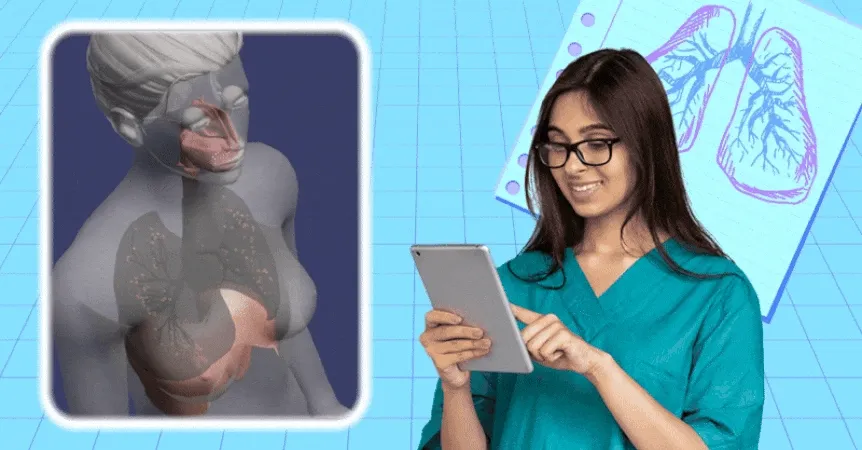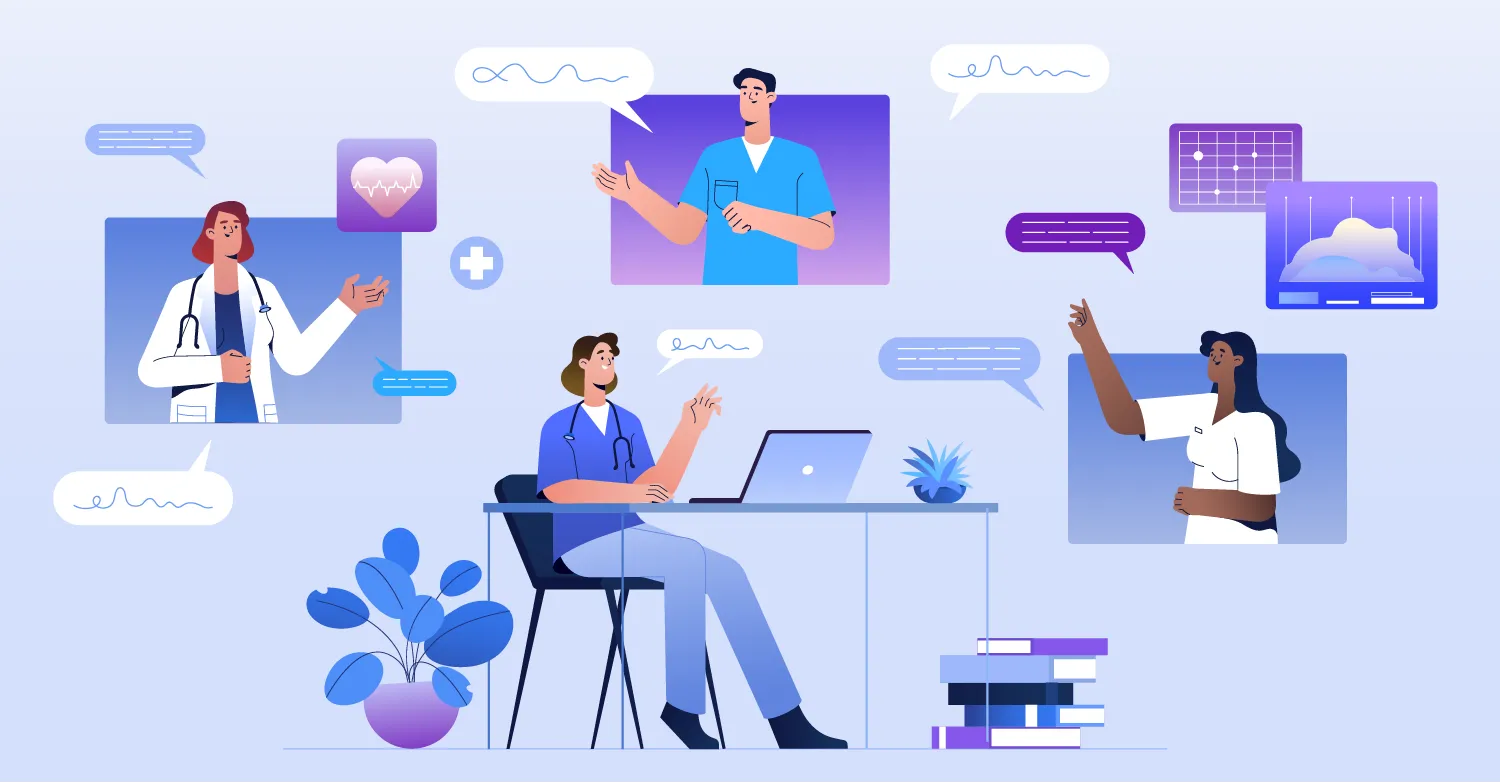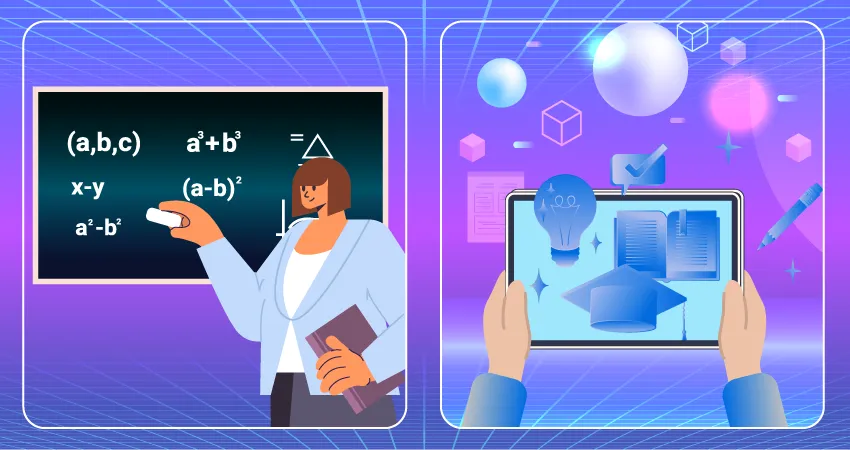Does Digital Simulation-Based Learning Actually Work? What the Evidence Says For Healthcare Education

Simulation: it’s a familiar topic for healthcare educators, and one likely to conjure up images of manikins and lab setups. But today’s simulation-based learning is characterized by a rich seam of examples that extend beyond the purely physical to encompass a wealth of digital, mobile-first, and augmented reality-powered experiences.
For healthcare educators, these more expansive manifestations of simulation-based learning open up evidence-backed ways to teach, learn, and reinforce the complex skills at the heart of a good healthcare education.
They hold the potential to help students gain valuable hands-on practice with no expensive hardware or limited physical space to account for. And when these outcomes can be achieved without increasing faculty workloads, there’s no question that this potential is worth investigating.
At the same time, healthcare faculty aren’t known for their abundance of free time. As such, even when simulation-based learning platforms are simple to implement and easy to use, it’s essential for interested educators to validate the most fundamental assumption about this technology: whether or not it works.
Read on to discover:
- What simulation-based learning means in a healthcare context
- Examples of the practice in action
- An evidence-led look at how digital simulation improves learning outcomes
 Simulation and Learning Solutions: From Definitions to Digital Practice
Simulation and Learning Solutions: From Definitions to Digital Practice
Simulation-based learning (and the tech that supports it) can take a wide variety of forms, and definitions of the subject tend to reflect that fact.
For David Gaba, writing in a 2004 article in Quality and Safety in Healthcare, ‘Simulation is a technique—not a technology—to replace or amplify real experiences with guided experiences that evoke or replicate substantial aspects of the real world.’
As Gaba points out, that definition isn’t limited to any particular technology, and this definition is elastic enough to encompass anything from the live-burn structures used in firefighting drills to the simulated cockpits used in aviation training.
In this case, we’re focusing on digital simulation and learning solutions that support: a means of replacing or amplifying real experiences with screen-based elements, from mobile-first 3D experiences to immersive augmented reality simulation.
These are the areas in which research on simulation’s effectiveness as a learning resource is particularly exciting.
Examples of Dental and Nursing Simulation in Action
Healthcare education lends itself to simulation. After all, clinical skills are often best practiced in settings that resemble the real world, whether that’s due to the hands-on skills students need to hone or the decision-making elements these disciplines demand.
And digital simulation holds plenty of advantages over traditional, physical approaches. In fact, as Dr. Martin Ling pointed out in an Immersify Q&A, injecting a digitally simulated patient with local anesthetic offers opportunities for learners to see the nerves they’ve impacted. This is a feature that’s simply not possible in conventional approaches: as Dr. Ling points out, patients aren’t typically transparent.
In nursing terms, meanwhile, digital simulation is a fantastic way to help students absorb and enact systematic approaches like ABCDE assessments. As registered nurses Hilary Gupte and Olivia Bradbury noted in our interview, digitally simulating relevant scenarios allows learners to repeat this key and complex process as often as is required to ensure total recall and understanding.
 Common Barriers to Adopting Digital and Augmented Reality Simulation in Healthcare Education
Common Barriers to Adopting Digital and Augmented Reality Simulation in Healthcare Education
Clearly, these examples showcase the substantial benefits that digital simulation-based platforms can offer. But such results can only be delivered when those platforms are in use, which (in the eyes of some) can present perceived challenges. For educators looking to make the case for simulation internally, it’s important to acknowledge how readily these challenges can be overcome with the right resources.
This is borne out in recent research, which notes that educators can (according to a 2025 study published in BMC Nursing) struggle with a lack of staff expertise when it comes to setting up and operating simulation tools.
And, while the BMC study places most of its emphasis on traditional simulation, the same is equally true of digital simulation. Data published in the Journal for Medical Extended Reality found that, among the clinicians, medical students, educators, and VR professionals it surveyed, barriers to adoption included:
- Skills of facilitator/educator (64%)
- Learning curve required to overcome (67%)
- Time constraint to implement (56%)
- Resistance to change (68%)
Of course, the right digital simulation platform simply won’t present these barriers in the first place. That’s why Immersify, for example, comes pre-aligned to curricula and why students and educators can access it via the smartphones, tablets, and computers they already own, sidestepping the question of faculty skills, learning curves, and implementation time.
But even the most accessible platform still needs to justify its place in a crowded curriculum, even if its impact is to improve the teaching experience. For educators making the case to colleagues or decision-makers, that means one thing: demonstrating that digital simulation meaningfully improves learning outcomes.
Luckily, there’s plenty of research to bear this out, too.
The Effectiveness of Digital Simulation-Based Learning in Healthcare Education: 3 Key Highlights
1) Improved Knowledge, Skills, Satisfaction, and Retention
In many ways, increases to knowledge and retention are educators’ lodestar: they’re the outcomes that are by far and away the most important for students to achieve. And the evidence suggests that these are exactly the gains on the table for those who embrace digital simulation:
- According to a 2023 meta-analysis published in BMC Medical Education, covering 1,167 nursing students across 12 trials, virtual reality simulations significantly enhanced theoretical knowledge, practical skills, skill retention, and even satisfaction levels.
This is a broad sweep encompassing just about every positive outcome educators could want for their cohorts. Of particular interest here is the lack of compromise: whereas traditional teaching might improve theoretical knowledge while dedicated lab time or clinical rotations might bolster practical skills, these results suggest that simulation neatly accounts for both needs at once.
DISCOVER THE PEDAGOGICAL STRATEGIES SIMULATION PLATFORMS UNLOCK | ‘Fitting the Pieces Together: 3 Easy Ways to Embed Pre-Mapped Learning Technology into Core Modules’
2) Augmented Reality in Nursing and Dental Education Can Boost Learner Engagement and Performance
VR tends to be the more widely researched technology in relation to simulation-based learning. In fact, this was acknowledged in a 2024 umbrella study on the use of VR and AR in healthcare education. Published in Frontiers in Digital Health, its review of 28 studies found:
- VR and AR are positively associated with improved learner engagement and performance.
The study goes on to note that expense can be a limiting factor in the case of VR, further underscoring the advantages of mobile-first AR as a means of offering both ease and access to educators and institutions looking to realize these learning benefits for themselves.
EXPLORE MORE BENEFITS OF NURSING SIMULATION PLATFORMS | ‘Why Clinical Rotations Are Under Pressure (And How to Protect Student Readiness)’
3) Digital Simulation Can Bolster the Teaching and Assessment of Psychomotor Skills
One of the key reasons simulation meshes neatly with healthcare education is that the latter relies, to greater or lesser degrees depending on the discipline, on practical skills. And when digital simulation can help to hone these skills, educators have every reason to take notice: it’s a means of enhancing critical areas of competence without requiring physical space or constrained placement and rotation opportunities.
- Following a meta-analysis published in a 2023 edition of the Journal of Professional Nursing, the researchers concluded that technology including AR and VR should be used in the teaching and assessment of clinical psychomotor skills.
- Notably, one of the studies covered by this review found that an AR-based anatomy training module left students better able to correctly place a nasogastric tube than the control group: a clear indication of the benefits of augmented reality in education.
- Psychomotor skills were also the subject of a meta-analysis published in Advances in Simulation: a wide-ranging review of 184 studies focusing on virtual, augmented, and mixed reality, the majority of which reported positive or partially positive effects of these technologies on learning outcomes.
Motor skills are obviously essential for a strong, well-rounded piece of healthcare education, but institutions will often encounter constraints in a highly practical sense: rotations can be hard to come by; sim lab access can be limited; preceptors and other supervisors aren’t always as available as educators might prefer.
In that light, studies that suggest practical skills can be honed without reliance on this array of limiting factors simply can’t be overstated in their significance.
FIND OUT MORE ABOUT THE SHIFT TOWARD SIMULATION-BASED LEARNING | ‘Embracing Digital Transformation in Healthcare Education Without Replacing Traditional Teaching’
The Case for Simulation-Based Learning: A Wide Consensus
Between them, these meta-analyses and umbrella analyses represent the findings of almost 300 individual studies covering AR, VR, and digital-simulation-adjacent forms of eLearning such as serious games and video guidance.
And, in each meta-analysis, the researchers involved concluded that digital simulation has a range of positive effects, from theoretical knowledge boosts to practical skill improvements.
The breadth of evidence on display here makes for a compelling case that well-designed digital simulation and learning platforms can transform retention, engagement, and success in healthcare education.
For educators keen to champion proven approaches within their institution, this collective evidence offers a powerful foundation for making the case.
Frequently Asked Questions on the Definition and Effectiveness of Simulation-Based Learning
Simulation-based learning uses structured, realistic scenarios to safely replicate clinical experiences for learners. Running the gamut from the physical (like manikins and standardized patients) to the digital (including virtual reality, augmented reality, and serious games), these simulations are designed to build competence and confidence before students enter real clinical settings.
Simulation is integral in teaching both technical skills (for example local anesthetic delivery) and non-technical competencies (like pharmacological decision-making including medicine prescribing). Digital formats, including AR and screen-based tools, offer scalable, flexible access that can complement or replace the need for physical labs and limited placement hours.
To see the effectiveness of simulation-based learning in action, take a look at the following case study: How Immersify’s Simulation-Based Learning Transformed UCLA Dental Students Into Trusted Prescribers
Absolutely: AR has a range of use cases across both disciplines. As a 2024 study published in the peer-reviewed Advances in Simulation points out, anatomy is one of the most prominent domains covered by virtual, mixed, and augmented reality in healthcare education, and both disciplines benefit from this approach. An AR platform might, for example, use a smartphone or tablet camera to turn the user’s face into a skull to aid in visualizing and understanding head and neck anatomy (and where better to learn than on your own face?).
Bring the Benefits of Digital Simulation to Your Students
The evidence is clear: well-designed digital simulation can transform the way healthcare students learn, practice, and retain critical skills. The challenge is finding a solution that’s simple to implement, aligned to your curriculum, and genuinely impactful.
That’s where Immersify comes in. Our AR and mobile-first simulations are ready to use from day one, with no specialist hardware, no steep learning curve, and no disruption to your existing teaching methods.
If you’re ready to explore how digital simulation could enhance your program’s outcomes, get in touch with our team or book a demo today.
This article was reviewed for clinical accuracy and educational relevance by Dr. Martin Ling, a GDC-registered dentist and Fellow of the Higher Education Academy.
Join our mailing list
Get the latest updates on immersive learning, industry trends, and resources delivered straight to your inbox.



